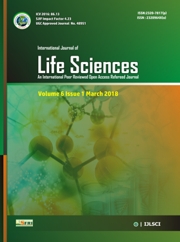RESEARCH ARTICLES
Volume 7 |Issue 5| Sept-Oct 2019 First published: 30 October 2019
Study on the ear microbes of school going children
1Nitin P Meshram and 2K Roychoudhury
1Department of Zoology, 2Department of Microbiology, S. K. Porwal College, Kamptee (M.S). [India]
*Corresponding author Email: nitinmesh2015@gmail.com
Abstract
Keywords: Mammal, Ear Microbes, Nutrient Agar, Johnson bud, Vancomycin.
Editor: Dr.Arvind Chavhan
Cite this article as:
Meshram Nitin P and Roychoudhury K. Study on the ear microbes of school going children, Int. Res. Journal of Science & Engineering, 2019, 7 (5): 105-114.
References
1. Juan KH, Lin SR, Peng CF. NCPI PMID: 2213960,1990; 6(8): 418-421.
2. Burkovski A. Corynebacteria Genomics and Molecular Biology. Caister Academic Press,2008; ISBN 978-1-904455-30-1 . http://www.horizonpress.com/cory.
3. Baron S, Davis C. Bacteriology. University of Texas Medical Branch at Galveston.C ,1996; pp. Chapter 6. Normal Flora.
4. Martin F, Clark J. Introduction to Audiology. Fourth ed. Upper Saddle River, 2014;NJ: Prentice Hall.
5. Singer D, Freeman E, Hoffert E. Otitis externa-bacteriological and mycological studies. Ann Otol Rhinol Laryngol, 1952; 61:317–30.
6. Karin M. Hearing Loss. 1991; New York.
7. Ryan KJ, Ray CG. Sherris Medical Microbiology (4th ed. Ed.). McGraw Hill, 2004; ISBN 0-8385-8529-9.
8. Moller A. Sensory Systems: Anatomy and Physiology. New York: Academic Press. 2000.
9. Todar K. Todar’s Online Textbook of Microbiology, 2007.
10. Mestel R. “Pinna to the Fore” Discover 14 June 1993: 45-54.
11. Dora A, Nayak D, Chawla K, Singh R Comparison of Microbiological Flora in the External Auditory Canal of Normal Ear and and Ear with Acute Otitis External J Clin Diagn Res 2017; 11(9): Mc01-Mc04.
25. Stroman DW, Roland PS, Dohar J, Burt W. Microbiology of normal external auditory canal. Laryngoscope,2001; 111, 2054-2059.
12. Ogston A. On Abscesses. Classics in Infectious Diseases”Rev Infect Dis, 1984; 6 (1): 122-28. PMID 6369479.
13. Alberti PW. The Anatomy and Physiology of the Ear and Hearing. Otologic Medicine and Surgery,(1988):54-63.
14. Brook I. Microbiological studies of the bacterial flora of the external auditory canal in children.ActaOtolaryngo 1981;l91:285-287.
15. Perry ET. Studies on the growth of bacteria in the human ear canal. Journal of investigative dermatology, (1956):165–170.
16. Quek SY, Otto M. Staphylococcus epidermidis and other Coagulase-NegativeStaphylococci”.Staphylococcus: Molecular Genetics. Caister Academic Press, 2008; ISBN 978-1-904455-29-5.
17. Belkaid Y, Segre J A. Dialogue between skin microbiota and immunity. In Science, 2014; pp. 954-959.United States: American Association for the Advancement of Science.
18. Kloos, WE, Schleifer, KH. "Staphylococcus auricularis sp. nov.: an Inhabitant of the Human External Ear". International Journal of Systematic Bacteriology1983; 33 (1): 9–14.
19. Vedamuthu ER, Nevile JM. Involvement of plasmid in production of ropiness muccmilk culture by streptococcus cremori, Application environmental microbiology,1986; 51: 677-682.
20. Wright D, Alexander J. Brigham Young Univ Provo Utah Dept Of Microbiology,1972; D0749816,08.
26. 22. Mosaei K , Ekrami A, Pedram M. JCRT,2006; (2) :17-19.
21. Ostfeld E, Segal J, Segal A, Bogokovski B. Isr J Med Sci. 1983; 19(12): 1046-9.
22. Dibb WL NIPH Ann. Jun 1990; 13(1):11- 6.
23. Gorems K, Beyene G, Berhane M, Mekonnen Z Antimicrobial susceptibility patterns of bacteria isolated from patients with ear discharge in Jimma Town, Southwest, Ethiopia BMC Ear, Nose and Throat Disorders (2018); volume 18, Article number: 17.
24. Mane PM, Basawraju A. Clinical significance of microbial flora in middle ear infections and its implications. Trop J Med Res, 2016; 19(2):128-130.
25. Benson H. Microbiological applications, A laboratory manual in general microbiology,(1967).

